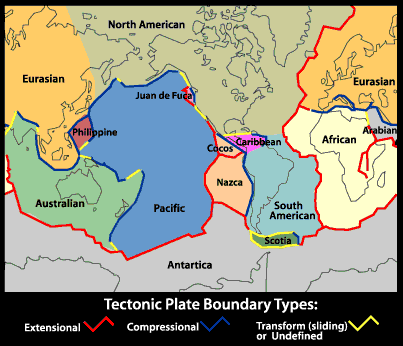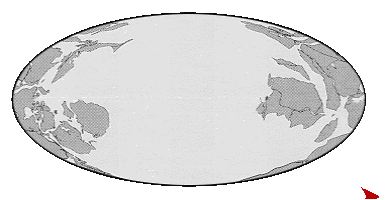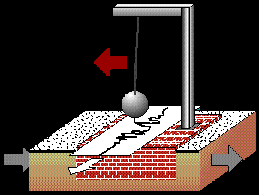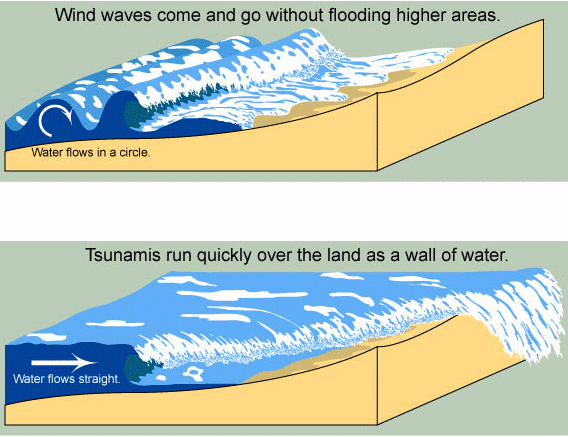Earthquakes
(Earthquakes are not associated with weather, but instead are
natural disasters.)
What is an
earthquake?
Earthquakes are the shaking, rolling or sudden shock
of the earth’s surface. They are the Earth's natural means of releasing
stress. More than a million earthquakes rattle the world each year. The West
Coast is most at risk of having an earthquake, but earthquakes can happen in
the Midwest and along the East Coast. Earthquakes can be felt over large areas
although they usually last less than one minute. Earthquakes cannot be
predicted - although scientists are working on it! 
Click Here to learn more about earthquakes from
USGS.
What causes an
earthquake?
There are about 20
plates along the surface of the earth that move continuously and slowly past
each other. When the plates squeeze or stretch, huge rocks form at their edges
and the rocks shift with great force, causing an earthquake. Think of it this
way: Imagine holding a pencil horizontally. If you were to apply a force to
both ends of the pencil by pushing down on them, you would see the pencil bend.
After enough force was applied, the pencil would break in the middle, releasing
the stress you have put on it. The Earth's crust acts in the same way. As the
plates move they put forces on themselves and each other. When the force is
large enough, the crust is forced to break. When the break occurs, the stress
is released as energy which moves through the Earth in the form of waves, which
we feel and call an earthquake. (Graphic Credit: Wheeling Jesuit
University/NASA Classroom of the Future)
Click Here to see an
animation of an earthquake. It's great for kids, because they get to see how it
actually happens!
What is a fault?
A fault is an area of stress in the earth where broken
rocks slide past each other, causing a crack in the Earth's surface. There are
the major types of faults: dip-slip normal, dip-slip reverse, strike-slip, and
oblique-slip.
What are plate tectonics?
The theory of plate tectonics is a interesting story of continents drifting from place to place breaking apart, colliding, and grinding against each other. The plate tectonic theory is supported by a wide range of evidence that considers the earth's crust and upper mantle to be composed of several large, thin, relatively rigid plates that move relative to one another. (See plate tectonic graphic above.) The plates are all moving in different directions and at different speeds. Sometimes the plates crash together, pull apart or sideswipe each other. When this happens, it commonly results in earthquakes.
 |
| Continental Drift: To see this animation again, just refresh this page! This animation shows you what our planet looked like millions of years ago and what it looks like now! (Graphic Credit: Geology Department at University of California, Berkeley) |
Click Here to learn more about plate tectonics and the drifting of our continents.
What is a seismograph?
A seismograph is an instrument used for recording the intensity and duration of an earthquake.

Click Here to calculate the strength of earthquakes!
What is a tsunami?
A tsunami is a large ocean wave usually caused by an underwater earthquake or a volcanic explosion. Tsunamis are NOT tidal waves. Tidal waves are caused by the forces of the moon, sun, and planets upon the tides, as well as the wind as it moves over the water. With typical waves, water flows in circles, but with a tsunami, water flows straight. This is why tsunamis cause so much damage!

Click Here to see an animation of an earthquake and the resulting tsunami. It's great for kids, because they get to see how it actually happens!
Click Here to get the latest tsunami warning information from the NWS.
Click Here for tsunami safety information.
EPICENTER - The point on the earth's surface directly above the source of the earthquake.
SEISMIC WAVES - The energy created by the quake travels in waves from the epicenter, where they are the strongest. The waves shake buildings, structures and the earth vertically, causing them to move horizontally!
RICHTER SCALE - A measurement of an earthquake's intensity. Each one-point increase on the scale indicates ten times the amount of shaking and 33 times the amount of energy. The energy released by a large earthquake may be equal to 10,000 times the energy of the first atomic bomb.
Click Here to see if there has been any recent earthquake activity across the U.S.
| 4 | Minor Earthquake |
| 5 | Moderate Earthquake |
| 6 | Strong Earthquake |
| 7 | Major Earthquake |
| 8 | Great Earthquake |
Click Here to learn about cool earthquake facts!
BEFORE AN EARTHQUAKE: Have a disaster plan. Emergency preparedness can save lives. Choose a safe place in every room. It’s best to get under a sturdy piece of furniture like a table or a desk where nothing can fall on you. Practice DROP, COVER AND HOLD ON! Drop under something sturdy, hold on, and protect your eyes by pressing your face against your arm. If you live in an earthquake prone area, bolt tall furniture to the wall and install strong latches to cupboards. Prepare a first aid kit for your home. By taking special precautions and checking for hazards before a disaster strikes, you will be much more likely to stay safe.
DURING AN EARTHQUAKE: DROP, COVER AND HOLD ON! Stay indoors until the shaking stops. Stay away from windows. If you’re in bed, hold on and stay there, protecting your head with a pillow. If you’re outdoors, find a clear spot away from buildings, trees and power lines. Then, drop to the ground. If you’re in a car, slow down and drive to a safe place. Stay in the car until the shaking stops.
AFTER THE SHAKING STOPS: Check for injuries. Inspect your home for damage. Eliminate fire hazards, so turn off the gas if you think its leaking. Expect aftershocks. Each time you feel one, DROP, COVER AND HOLD ON.
Lesson Plan: Here is a great lesson plan on learning about how thrust faults are responsible for the uplift of many mountain ranges across the world, including the Los Angeles Basin. This is a great lesson plan for middle and high school students.
Lesson Plan: Here is a great lesson plan keeping track of earthquakes around the world. In this activity, kids keep a record of the location of earthquakes for a week and learn about plate tectonics.
Earthquake Experiment: Here is a great experiment that explains how to prepare for an earthquake.
Science Fair Ideas: Here is a list of science fair project ideas that deal with earthquakes.
Science Fair Project Ideas: Here is a complete list of science fair project ideas. Discover the science behind the weather that impacts us every day.